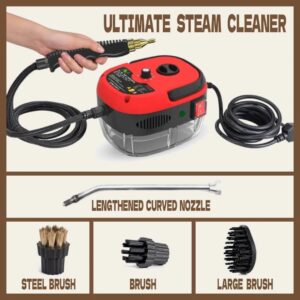Window cleaning tools 2025 are set to revolutionize the way we approach cleanliness and maintenance in both residential and commercial settings. As technology advances, these tools offer innovative features that enhance efficiency, making it easier than ever to achieve streak-free results without the hassle of traditional methods.
From automated robotic cleaners to advanced squeegees with ergonomic designs, the latest tools promise not only to save time but also to deliver superior results. This overview will explore the key innovations, essential features to look for, and the different types of cleaning tools available this year.
Window Cleaning Tools Overview

The window cleaning industry in 2025 has witnessed remarkable advancements in technology and design, making the task of cleaning windows more efficient and user-friendly. With the integration of smart technology and ergonomic design, modern window cleaning tools are set to enhance both commercial and residential cleaning practices.The latest innovations encompass a range of features that significantly improve the window cleaning process.
High-performance squeegees with adjustable handles, telescoping poles that extend to unprecedented lengths, and robotic window cleaners that can operate autonomously are just a few examples of how technology is reshaping this field. Furthermore, the benefits of using advanced window cleaning equipment include reduced cleaning time, improved safety for workers, and superior cleaning results with less physical strain.
Innovative Features of Modern Window Cleaning Tools
When considering new window cleaning tools, consumers should be aware of essential features that make these tools effective and efficient. Understanding what to look for can lead to better purchase decisions and a more satisfactory cleaning experience. Some key features to consider include:
- Smart Technology Integration: Many modern tools now come with app connectivity, allowing users to operate robotic cleaners or track cleaning schedules through their smartphones.
- Ergonomic Design: Tools that are designed to reduce strain on the body help prevent injuries, especially for professional cleaners who frequently use them.
- High-Quality Materials: Look for tools made from durable, lightweight materials, such as carbon fiber or high-grade plastics, which enhance both longevity and ease of use.
- Adjustable Features: Telescoping poles and adjustable squeegees accommodate various window sizes and heights, making them versatile for different cleaning tasks.
- Eco-Friendly Solutions: Some newer tools use environmentally-friendly cleaning solutions, minimizing the impact on both the user and the environment.
The focus on these features not only elevates the cleaning experience but also aligns with modern sustainability goals, ensuring that consumers can maintain cleanliness while being mindful of their environmental footprint.
“The right tools not only increase efficiency but also elevate the standard of cleanliness achieved in window cleaning tasks.”
Types of Window Cleaning Tools

In 2025, the variety of window cleaning tools has expanded significantly, catering to different preferences and cleaning needs. Whether you’re a professional cleaner or a homeowner looking for efficient solutions, understanding the available tools helps maximize your cleaning efforts while ensuring safety and quality. The landscape of window cleaning tools now encompasses both traditional and modern innovations. Traditional tools like squeegees and scrubbers have stood the test of time, while electric and robotic cleaners offer advanced technology for convenience and efficiency.
Below, we will dissect these tools and examine their respective advantages and disadvantages.
Traditional Window Cleaning Tools
Traditional window cleaning tools have been utilized for decades and still remain popular for their simplicity and effectiveness. Key types include:
- Squeegee: A handheld tool featuring a rubber blade attached to a handle, essential for removing water and cleaning solutions from glass surfaces.
- Scrubber: Often a sponge or microfiber cloth attached to a long handle, scrubbing tools are designed to apply cleaning solutions and agitate dirt before removal.
- Bucket: Used to hold cleaning solutions, a bucket is a staple for traditional cleaning methods, allowing easy access to water and detergent.
- Extension Poles: These poles help extend the reach of cleaning tools, making it possible to clean high or hard-to-reach windows safely.
Traditional tools offer several benefits, such as low cost, ease of maintenance, and no reliance on electricity. However, they require physical effort and may pose safety risks when reaching elevated windows.
Modern Electric and Robotic Window Cleaners
Modern advancements have paved the way for electric and robotic window cleaners, which provide an entirely different cleaning experience. These tools leverage technology to automate the process, making it more efficient and less labor-intensive. Key types include:
- Electric Window Cleaners: Handheld devices that typically feature a built-in vacuum and squeegee, allowing for quick cleaning with minimal physical effort.
- Robotic Window Cleaners: Autonomous machines that can navigate windows and clean surfaces without human intervention. They often come equipped with sensors to avoid obstacles and adjust to different glass types.
The advantages of electric and robotic cleaners include significant time savings and the ability to clean without strenuous manual labor. They are particularly useful for large buildings or multi-story homes. However, they tend to be more expensive upfront, and their reliance on technology can lead to malfunctions requiring repairs or maintenance.
“Choosing the right window cleaning tool ultimately depends on personal preferences, cleaning needs, and the specific characteristics of the windows being cleaned.”
In summary, each type of window cleaning tool—traditional or modern—comes with its unique set of advantages and disadvantages. Understanding these differences allows users to make informed choices that best suit their cleaning tasks.
Selecting the Right Cleaning Tools
Choosing the right window cleaning tools is essential for achieving optimal results in various environments. Factors such as the type of windows, building height, and frequency of cleaning all play a critical role in determining the appropriate tools to use. Selecting the right tools ensures efficiency, safety, and the longevity of both the equipment and the windows being cleaned.
Factors to Consider When Choosing Window Cleaning Tools
When selecting window cleaning tools, several factors influence your final decision. Understanding these considerations can enhance the cleaning process and produce better results. The key factors include:
- Environment: Identify whether the windows are in residential homes, commercial buildings, or high-rise structures. For instance, residential windows often require less specialized equipment compared to commercial or high-rise windows.
- Window Type: Different window styles (casement, double-hung, sliding) may require specific tools, such as squeegees with various blade sizes or extension poles for hard-to-reach areas.
- Frequency of Cleaning: Tools used for regular cleaning might differ from those employed for deep cleaning. Heavy-duty scrubbers and specialized glass cleaners may be necessary for infrequent, thorough cleans.
- Safety Considerations: High-rise window cleaning necessitates equipment that adheres to safety standards, such as harnesses and scaffolding, to ensure the safety of workers.
Organizing a Toolkit for Residential Versus Commercial Window Cleaning
An organized toolkit is crucial for efficiency and effectiveness during the cleaning process. The toolkit will vary considerably between residential and commercial applications due to the different requirements and challenges presented by each environment. Here’s a structured approach to organizing these toolkits:
- Residential Toolkit:
- Basic squeegee with a rubber blade
- Microfiber cloths for polishing
- Scrub pad or sponge for dirt removal
- Extension pole for high windows
- Bucket for holding cleaning solution
- Commercial Toolkit:
- Heavy-duty squeegee with interchangeable blades
- Window cleaning solution with commercial-grade effectiveness
- Telescoping poles to reach high floors
- Safety harness and ropes for high-rise cleaning
- Heavy-duty scrubber for large glass surfaces
- Tool belt for easy access to essentials
Maintenance and Storage of Window Cleaning Tools
Proper maintenance and storage of window cleaning tools are crucial for their longevity and performance. Neglecting these aspects can lead to decreased efficacy and increased replacement costs. Here are effective strategies for maintaining and storing these tools:
- Regular Cleaning: Rinse squeegees and scrubbers after each use to prevent dirt buildup. This step is vital for preserving the integrity of the cleaning materials and avoiding scratches on glass surfaces.
- Proper Drying: Ensure tools are completely dry before storing them. This action helps prevent mold, mildew, and rust, especially in metal components.
- Safe Storage: Store tools in a dry, cool place. Use a dedicated toolbox or storage container to keep everything organized and protected from environmental damage.
- Routine Inspection: Regularly inspect tools for wear and tear. Replace any damaged parts promptly to maintain optimal cleaning performance.
“Investing time in proper maintenance and organization of your toolkit will result in significant time savings and improved cleaning outcomes.”
Concluding Remarks
In conclusion, the landscape of window cleaning tools in 2025 presents exciting options that cater to diverse needs and preferences. Whether you’re a homeowner looking to maintain your property or a business owner seeking efficient solutions, understanding these tools and their features will empower you to make informed choices for sparkling clean windows.
User Queries
What are the latest technologies in window cleaning tools?
The latest technologies include robotic window cleaners, smart sensors, and eco-friendly cleaning solutions that enhance performance and efficiency.
How often should I clean my windows with these tools?
It depends on your environment, but generally, it’s recommended to clean windows at least twice a year, or more frequently in areas with high dust or pollution.
Can robotic window cleaners handle different window types?
Yes, many robotic window cleaners are designed to work on both vertical and horizontal surfaces, adapting to various window types.
Are advanced window cleaning tools worth the investment?
Absolutely, they save time, improve results, and often come with features that enhance safety and reduce physical effort.
How do I maintain my window cleaning tools for longevity?
Regularly clean and store them properly, following the manufacturer’s guidelines, to ensure they remain effective and durable.




